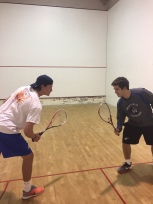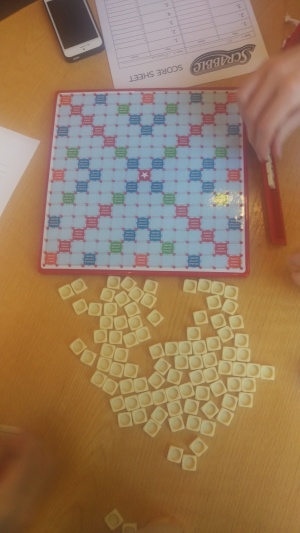Digital literacy strikes many chords with both readers and writers alike. Scholars of technology and media culture have meaningful points to make regarding the use of digital environments. Richard Lanham defines digital literacy as “the ability to understand information, however it is presented” (Lanham). He adds to our understanding of literacy in the digital age by discussing the ways in which multi-modal features are adjoined with “old-fashioned ‘literacy'” which was printing black letters on a white page. Lanham explicitly points to a multimedia mixture that exists in our current digital environments. He foreshadows the volatile nature of digital literacy as both a new danger and excitement. Lanham contributes to the conversation made by other writers about the usefulness of technology and the impacts on information gathering. With “sense and restraint,” Lanham presents a “credible public self,” one both multi-modal and deliberate. In writing this piece at his age, Lanham passes on his wisdom to the younger generation. A toddler may never stumble upon this article on an iMac. That person may never see the link when that person grows up. The multimedia features Lanham presents may be visited and revisited again and again. His geekiness and thick rimmed glasses may never be emulated in real time the way Lanham composes the website. His idea of digital literary arrives at his life cycle with the culmination of his dorkiness. Like Postman or Hughes, Lanham has much to say regarding digital environments and is to be cited on WordPress. These individuals are literate prior to the World Wide Web. They continue to hold literate qualities despite Lanham’s plain looking web domain. While their sphere of influence is only creeping towards the digital, their array of expertise unfolds, as does the ultra web.
Neil Postman warns readers of the twenty-first century of the Faustian bargain side of technology. He argues that new technologies are an “unmixed blessings” and “liabilities” (Postman, 27). The more technology enhances society it also harms its users at the same moment. Postman’s healthy skepticism of technology’s ruse pervades the literature on digital access. He approaches the matter of technological breakthrough with the same grain of salt of similarly recent innovations such as the growth of the automobile or of medical practices. Postman notes that automobiles “degraded the beauty of our natural landscape,” medical technology reduced “the diagnostic skills of physicians,” and that the printing press “reduced religious sensibility to a form of fanciful superstition” (Postman, 27). These three modern technologies brought together a dynamic, new democracy. The Internet provides access to literature to more minds than any previous methods of communication. All considered western inventions, the printing press in particularly, centers the origin myth on Anglo roots. Postman mentions, “printing reduced God to the dimensions of a local potentate” (an Englishman or a German or a Frenchman); technology will undo a phenomenon too current and too vast to understand at the moment. This was Postman’s first idea in his “Five Things We Need to Know About Technological Change” concerns (Postman, 26). The first and foremost critique of technology made by Postman et. al is her vulnerability. Postman passed away a dozen years ago. His envisioning of the modern intranet is not considered outdated. His skepticism of the good of technology remains heard.
Sherry Turkle, in “Alone Together” discusses the potential benefits and drawbacks of increased human interaction with robots and machines (Turkle, 85). She suggests that technology has simplified the way humans see and approach the world. Artificial intelligence manifests herself through the use of smartphones, smart television, iMacs, and smart cars. Highly industrialized society is highly reliant on electricity and her endless abilities. A good example of locations where technology is particularly emphasized is by examining the use of automatons in Tokyo, Japan. As a college student in Central Pennsylvania, news about robot friends in Japan comes to my attention through the classroom. A professor of East Asian Studies here at Dickinson points out fascinating new environments catalyzed by robot allies. Turkle seems to discuss a similar train of thought that is the invasion of machines in the social interactions of humans. She worries that people nowadays “romance the robot and become inseparable from our smartphones” (Turkle, 86). To bring the point home, Turkle mentions the social substitution networked devices offer the elderly: “‘it’s like having a little Times Square in my pocketbook. All lights. All the people I could meet'” (Turkle, 86). The author was referring to a woman in her late sixties fidgeting with her new iPhone. As phones and computers entertain both the old and the young, the access to the world has never been even more salient. Tablets are creeping on smartphones and personal computers as a middle ground for even more technological convenience. The mandated purchasing of iPads at select high schools across America testifies to the domination of new electronic products in education. Combined with the criticism of media scholars, Postman and Turkle address the issue of the technological boom of the millennial generation. The dotcom bubble has unleashed a new danger infusing silicon valley with wall street with main street.
So much talk exists around the definition of technology. From a historical perspective, technology has been tools that have enhanced the Homo sapiens race. The earliest innovations include fire, the wheel, and sharp objects. Medieval weaponry is not limited to vessels, catapults, and mills. Industrial breakthroughs mention the cotton gin, the printing press, and the postal system. Last but not least, our postmodern age boasts of Facebook, quantum mechanics, and string theory. None of these terms are equivalent or nonequivalent. There is no intention of ranking or placing greater or lesser importance to any of these technological entities. The point being addressed here is the magnanimous effect of all of these innovations on the trajectory of human beings. Fire may have existed for hundreds of thousands of years and allowed for our ancestors to stay warm and fend off wolves. Sharp objects allowed hunters and gatherers tools necessary to settle down and cultivate the land. Steam engines and fossil fuels gave industrial nations the leg up to become digitized. The shift from a labor economy to a service one is as new of a phenomenon with vast cultural implications. Economists and political scientists may further address the supply side of technology. Some of the scholars mentioned in this essay are sociologists and psychologists of media. They define technology as according to journals and societies dedicated to the understanding and advancement of technology. Those mentioned in the following are historians, writers, and journalists who have meaningful comments on the evolution of modern technology.
In Technology: A Reader for Writers, professors of digital sociology discusses the definition of technology. Thomas Hughes explains that technology and engineering are parallel words. Their meaning diverged in the late 1950’s when scientists ascribed different implications for the two synonyms (Hughes, 5). He asserts that technology has become the “overarching definition” covering subcategories of engineers, scientists, and machines (Hughes, 5). Hughes goes to mention how knowledge, bio-engineering, and creativity could be considered technology as well. As a trained electrical engineer who later completed a PhD in history, Hughes emphasizes the necessary blend between both physical and social sciences. His years of expertise helped him conclude that technology may now umbrella most modern sciences. From intelligent robots to architects of modern high-rises, these additions to society incorporate the use of technology in some way. Hughes calls these notions of applied science as “practical arts” (Hughes, 4) and suggest their being joint at the hips. As a result, Hughes portrays the relationships between all sciences as a landscape including “trees, rocks, mountains, lakes and seas” (Hughes, 5). The relationship between nature and media is drawn into comparison with statements such as these. Like Lance Hosey’s “Why we love beautiful things” New York Times article, Hughes would agree that beauty exists in all categories including nature. Hughes has a working definition of technology unlike other historians or scholars of journalism. He points out that technology has become a way to discuss all matters pertaining to the advancement of the human trajectory. Since the fifty or sixty years when the Society for the History of Technology made the distinction between the word engineering and the word technology, the latter has prevailed as the discourse for modern innovations.
In order to understand digital writing, one must put into context the impact of technology on our lives. Sarah Murray helps readers put into perspective the impact of the millennial generation on technology and vice-versa. Like some of the other scholars mentioned, Murray describes the democratic features of the Internet in “Transition: Technology Puts Power in the Hands of Many.” He said, “Online tools and smart devices have empowered the generation born since 1980 in a way few previous technologies have done” (Murray, 11). Some of those previous technologies might include pen and paper, the typewriter, and the printing press. All of these mentioned have a profound impact on academia. Digital literacy has emerged as the front runner and the direction for learning in today’s age. Online resources such as Khan Academy and Blackboard now exist in every middle school’s curriculum. The incorporation of technology in today’s classroom will revolutionize the way people see and interpret the world moving forward. Yet experienced historians such as Hughes and Postman may heed caution to the growth of digital media in our society. The implication of rapid digital changes is yet to become fully realized due to its ongoing nature.
To be digitally literate in today’s world means so much more than having access to Web MD or Facebook. On the level of higher education, courses dedicated to learning in and for digital environments provide students with the fundamentals to approach the 21st Century. The demands of emerging technology progresses at a rate greater than any Google N-gram could measure like Schatzberg indicated with his “What is Technology” excerpt. In order to move beyond an intellectual understanding of technology towards an applied approach, students may have to consider different perspectives. What digital literacy is and has become differs to each individual’s experience with digital environments. There is so much web content available to college students that no student alone will ever surf the web in the same manner. Like an algorithm for chess players, no two games will be played the same exact way provided that no structured directions were given. One must become digitally literate at his or her pace and according to their tastes. A college course may theorize a good blog or website but only the account holder may submit the button to post a certain publication. Software such as WordPress is allowing those willing to create their own journals on their server. The digitally literate range from the avid poster and commenters online to the patient and quiet reader. Some may leave a huge technological footprint while others may not walk down that path.
David Haley discusses some of the more contemporary disciplinary advances in Readercentric Writing for Digital Media: Theory and Practice (Haley, ). He discusses the ways in which writing has become specialized even online. Haley suggests that different fields of expertise should merge their writing techniques towards a singular stream. He states one of six major problems with technical writing:
“Worse, in an environment where ‘anybody can write,’ engineers, IT professionals, programmers, secretaries, artists and (more recently) computers can all become technical writers and publications managers. Many base their writing models on assumptions that have no rhetorical foundation whatsoever. I have seen professional editors conclude that an effective approach to single sourcing is to write for a single, universal audience— not to bother with audience analysis. For a person with little rhetorical grounding, this might seem like an excellent idea. For anybody who understands writing theory, it is a disastrous idea. Still, lacking a vocabulary, writers have difficulty explaining why the idea of writing to a universal audience is such a mistake. ”
This divided approach to writing is the second major problem according to Haley. Other problems with digital environments include being part of a collective identity, to not have access to equal amounts of educational resources, and the mass consumption of similar digital goods. From secretaries to IT professionals, Haley notes that each field of specialization requires a particular coherence to its language. This is problematic in serving the audience that they address. The language of a programmer differs from that of an artist. Their clientele are often mixed and disinterested in the two different fields. Postman and Hughes warn us of this digital division. The transition from separated techniques to a universal audience is a challenge. The effort to conduct a single stream digital media would maximize the reach of online literature.
Taking this course sets me on the path of an informed blogger required to publish this paper along with a handful of free topic posts. Even with this expectation, a digitally literate student could rock the boat or that person could type each word carefully. To be well versed in a digital environment requires awareness of these dimensions. As each person would like his or her voice to be heard at his or her own discretion, that person cannot entirely escape the prevalence of electronic devices linked with web access. Stories of peers who travel abroad and deactivate their Facebook accounts end up reactivating some form of social media when they are ready to wire in and share their stories as they come to the web. To not have a Facebook account at this moment would literally equate to be living under a rock. So much of Millennial’ thoughts are expressed through online forums. Missing out on the trends of peers and current news would render that person digitally illiterate. Digital writing has become both powerful and dangerous. Users of technology should consider the warnings of Lanham and Postman and navigate their new environments with poise. Web presence differs according to the website and the web audience. Bloggers may be alone together or accompanied indefinitely depending on how one perceives Turkle’s point about the invasive but reassuring qualities of web access. Bloggers are part of an expanding online community of literate consumers of the web. Their drive varies and their purpose differs. They come from different levels of educational attainment, different levels of privilege, and different means to resources. To blog does not make one digitally literate. To have web presence does not make one well inform either as anyone with rudimentary language skills may use technology. As a student in this course, I must attempt to strike a balance between cautious steps into blogging and safe digestion of web content. In doing so, I hope to contribute to the blogging community on campus with purpose.
Works Cited:
Hailey, David. Baywood’s Technical Communications Series : Readercentric Writing for Digital Media : Theory and Practice. Amityville, NY, USA: Baywood Publishing Company, Inc., 2014. ProQuest ebrary. Web. 29 October 2015.
Lanham, R. (1995). Digital Literacy. Scientific American (September 1995). <http://www2.idehist.uu.se/distans/ilmh/Ren/lanham-digital-lit.htm>
Rajchel, Jen. “Consider the Audience.” Web Writing: Why and How for Liberal Arts Teaching and Learning. Eds. Jack Dougherty and Tennyson O’Donnell. Trinity College ePress edition, 2014. EBook. 30 October 2014.
Rorabaugh, Pete. “Organic Writing and Digital Media: Seeds and Organs.” Hybrid Pedagogy (2012): n. pag. Web. 29 Oct. 2015 <http://www.hybridpedagogy.com/journal/organic-writing-and-digital-media-seeds-and-organs/>
Zappen, James P. “Digital Rhetoric: Toward an Integrated Theory.” Technical Communication Quarterly 14.3 (2005): 319-25. Print.







 I can safely say that I did about the same amount of running as she did just to get the ball back. I had to trick her multiple times just so I could pry the ball out of her jaws of death. She wasn’t giving it up even for a TREAT.
I can safely say that I did about the same amount of running as she did just to get the ball back. I had to trick her multiple times just so I could pry the ball out of her jaws of death. She wasn’t giving it up even for a TREAT.

 iend, my teammate and also my roommate. I do everything with this 5’7″ kid and I usually beat him in everything we do. Losing to him is my nightmare.
iend, my teammate and also my roommate. I do everything with this 5’7″ kid and I usually beat him in everything we do. Losing to him is my nightmare.
 My house is big and we are 24 people living here. We are five Teaching Assistants (Amanda from Brazil, Irene from Spain, Marie from France, Riccardo from Italy and me) and people who are studying a romance language. The ‘internationals’ are experiencing something else than just sharing the house. Every time somebody feels sad, homesick, tired or disappointed, there is always other foreigner ready to listen to the other. The same happens with happy or rewarding moments we love sharing. We don’t have our friends and family from our places so the ‘international family’ is crucial to enjoy this Dickinson experience to the most. We are more than 5 in this Dickinson family. There are other TAs from Russia, Germany and Egypt. They live in other houses, but we share lunch, dinner and weekends.
My house is big and we are 24 people living here. We are five Teaching Assistants (Amanda from Brazil, Irene from Spain, Marie from France, Riccardo from Italy and me) and people who are studying a romance language. The ‘internationals’ are experiencing something else than just sharing the house. Every time somebody feels sad, homesick, tired or disappointed, there is always other foreigner ready to listen to the other. The same happens with happy or rewarding moments we love sharing. We don’t have our friends and family from our places so the ‘international family’ is crucial to enjoy this Dickinson experience to the most. We are more than 5 in this Dickinson family. There are other TAs from Russia, Germany and Egypt. They live in other houses, but we share lunch, dinner and weekends.
 My accent, my words learned from a book, not from real conversations and my anxiety to finish a sentence were not the best combination. I felt my broken English was getting ‘broker and broker’ (It is a short adjective so I should add –er, right? I mean, I learned it that way, but many people say ‘more big’ and not ‘bigger’! Whatever, somebody will understand me!)
My accent, my words learned from a book, not from real conversations and my anxiety to finish a sentence were not the best combination. I felt my broken English was getting ‘broker and broker’ (It is a short adjective so I should add –er, right? I mean, I learned it that way, but many people say ‘more big’ and not ‘bigger’! Whatever, somebody will understand me!)





